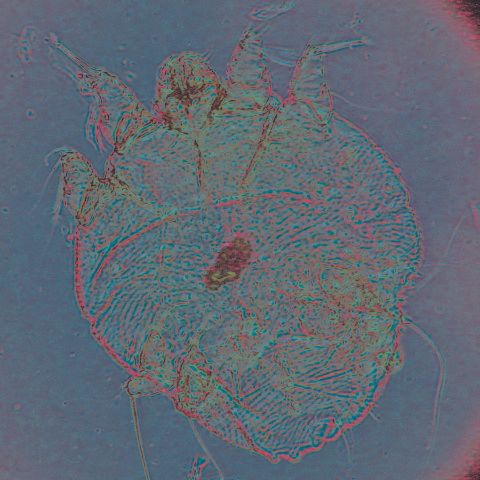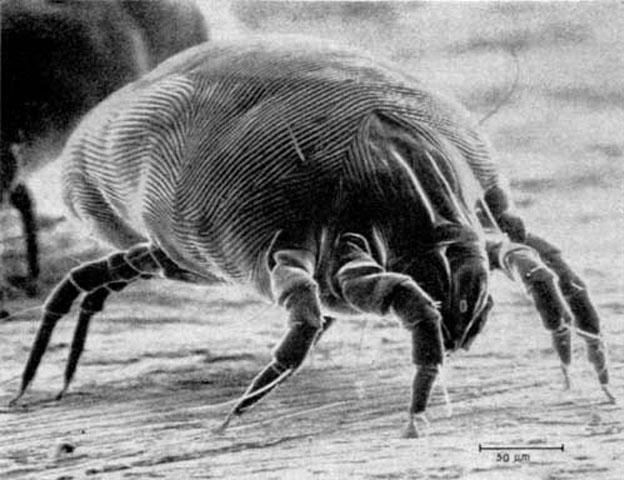
Credits: UF/IFAS
Mites are small arthropods with two body regions, sucking mouthparts, no antennae, and four pairs of legs as adults. The life cycle of a mite is generally composed of four active stages: egg, larva, nymph, and adult. The life cycle usually requires one to four weeks and may result in huge populations of mites when there are favorable conditions. There are more than 250 species of mites known to cause health-related issues to humans and animals.
Household Mites
Mites are occasionally found in homes and attack humans in the absence of their normal hosts; birds, rodents, or insects. Bites from these mites may be painful and cause severe skin irritation.
Bird Mites
The northern fowl mite (Figure 1), tropical fowl mite, and chicken mite are the major bird mite species in Florida. The northern fowl mite is the species of most importance in the state, and it causes serious problems to birds, particularly chickens. However, it occasionally attacks humans.

The adult, female, fowl mite lays eggs on the host bird. The eggs hatch in one to two days into the six-legged larval stage, which does not feed. The larvae molt to the nymphal stage in about eight hours. The nymphs and adults have piercing mouthparts and seek blood meals. The complete life cycle from egg to egg-laying adult can take five to seven days or longer, depending on the environment.
Bird mites are encountered in homes usually when they migrate from bird nests in eaves, rafters, or gutters. They prefer to feed on fledglings in the nest, but when the young leave the nest, the mites migrate to other areas in search of a blood meal. Many times, infestation of buildings occur when roosts and nests of birds are disrupted or destroyed.
Insect Mites
The straw itch mite (Figure 2) is the most prevalent insect parasite that also attacks humans. The straw itch mite is almost invisible because of its small size. Infestations from alfalfa, hay, and barley can produce irritation.

Credit: USDA/ARS
The mites are parasitic on the larvae of insects such as the Angoumois grain moth, the wheat jointworm, and furniture beetles. The female mite retains up to 300 eggs in her body, and the immature stages develop to adults inside the female. Upon emerging they search for hosts to parasitize.
In humans, the bites of the straw itch mite are located almost entirely on the clothed portions of the body. Dermatitis results from reaction to the bites within 24 hours. Humans become infested when they come in contact with straw, grain, or wood. where the mites are present. Houses may become infested when the insect hosts of the mites are present.
Rodent Mites
The two most abundant rodent mites in buildings are the tropical rat mite (Figure 3) and the house mouse mite. Rodent mites are primarily external parasites of rats and house mice, but they will also feed on humans.

The life cycle of rodent mites is similar to the bird mites. The life cycle usually takes from 10 to 12 days.
Rodent mites can cause severe irritation and dermatitis in humans. Areas bitten by mites may remain swollen for several days and leave red spots. Scratching of bites often can result in secondary infection.
Control
Control of household mites is best accomplished by eliminating nests and roosting areas for birds, controlling rodents, or controlling insect hosts. Household mites can be controlled with indoor space sprays. These products are effective in killing mites but do not prevent reinfestation. Application may need to be repeated in two to three weeks.
Mites often invade structures from crawl spaces or attics. Residual crack and crevice treatments can be used to kill mites as they crawl into rooms.
Mites sometimes invade structures from perimeter infestations. These mites can be prevented from entering buildings by applying an outdoor barrier treatment.
Bites should be treated with antiseptic, and a local anesthetic may be applied to ease the irritation. Persons with severe dermatitis caused by mites should consult their physician for proper treatment.
Scabies Mites
Biology
The scabies mite (Figure 4) or human itch mite burrows into the outer layers of the skin of humans causing human mange or scabies. Different varieties of scabies mites are specific for certain mammals including man, domestic animals, and wild animals.

Credit: Kalumet (CC BY-SA 3.0)
The female mite makes long burrows in folds of skin. The female lays from 40 to 50 eggs in the burrow. The larvae and nymphs develop and burrow in the skin. The total life cycle takes one to three weeks depending on the environment.
Transmission
Scabies mites are transmitted from one person to another by direct contact or also by two people who share the same bed. People are most likely to become infested when living in crowded quarters with other people. Dog scabies often can be transmitted to man under ideal conditions.
Symptoms
Persons infested with scabies suffer severe itching. A rash may develop later as the person becomes sensitized to the mites. The rash usually occurs around armpits, the wrists, the waist, and back of the calves. Even though only a few mites may be present, the rash may spread over much of the body.
Control
If scabies mites are suspected, a physician should be consulted for diagnosis and treatment. If dog scabies transmission to man is suspected, a veterinarian should be consulted for treatment of the dog at the same time that the human is treated.
House Dust Mites
The house dust mites, or floor mites (Figure 5), are increasing in medical significance to humans. The importance of house dust mites is that pieces of the mites in house dust may produce allergic reactions and asthma when inhaled. It is presently estimated that 4% of the human population suffers with house dust allergy.

Credit: U.S. Food and Drug Administration
Biology
The adult, female, house dust mite is approximately 1/64 inch (0.4 mm) long, and the males are even smaller. Because of their small size these mites are often overlooked in a house. The adult female lays about an egg a day for 30 days. The eggs hatch and develop to adults, in about one month.
House dust mites feed on the shed skin of humans. It has been estimated that the average person sheds approximately 5 grams of skin per week. One gram of skin will feed thousands of mites for months.
The house dust mite is found commonly in houses and schools throughout the United States. The most common habitat for the mite is in thick carpeting, heavy curtains, fabric covered furniture, beds, and pillows.
Mite Allergy
House dust mites, their fragments, and excretory, or secretory products, are the most important allergens found in house dust. Asthmatic symptoms after exposure to house dust have long been known. Only recently it has been shown that the house dust mites, like pollen, can be the potential producers of allergic responses when inhaled.
Asthmatic patients often suffer aggravated symptoms when they go to bed because of increased exposure to house dust mites. Often patients who are hospitalized improve dramatically because of less exposure to house dust.
Control
Frequent changing of bedding and use of nonfibrous bedding will reduce mite populations. Frequent vacuum cleaning and correction of excess humidity problems will aid in mite control. Use vacuums equipped with HEPA filters. HEPA air cleaners and HEPA air filters for air and heating units can help reduce allergen effects.
Remove carpeting where possible. If carpeting cannot be removed, use an appropriate acaricide application, following the label instructions.